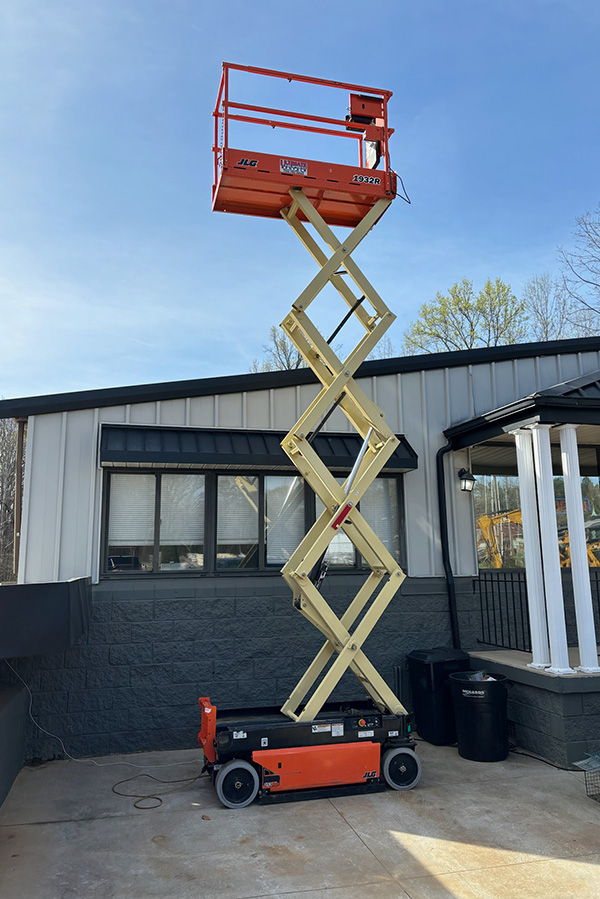A scissor lift can help with any job, big or small, effectively and efficiently. The most important aspect of a scissor lift is safety – they allow for a diverse range of activities to be completed most safely. If you are considering renting a scissor lift, you will want to keep reading. We are covering everything you need to know about a scissor lift before you rent one!
What is a Scissor Lift?
A scissor lift is a type of aerial work platform (AWP) used to provide temporary access to elevated areas. Unlike other aerial lifts that may extend with a telescoping boom or articulating arm, scissor lifts use a crisscrossing (X-pattern) metal support structure that elongates and contracts, raising and lowering the platform vertically. This unique design makes scissor lifts highly stable and suitable for a variety of tasks that require vertical movement.
How High Can a Scissor Lift Go?
Scissor lifts come in a range of heights to suit different needs. The working height of a scissor lift typically ranges from 15 to 50 feet. Here’s a general breakdown:
- Low-Level Lifts: They provide a working height of up to 20 feet, ideal for indoor maintenance and installations.
- Medium-Level Lifts: These lifts offer a working height between 20 and 40 feet, suitable for a wider range of indoor and outdoor tasks.
- High-Level Lifts: These lifts can reach up to 50 feet or more, perfect for high-ceiling indoor work and outdoor construction projects.
Ultimate Equipment Rentals offers a 19 foot and 26 foot scissor lift that can handle most work you should need to complete. We offer daily, weekly, and monthly rentals for your convenience.

Common Uses for Scissor Lifts
Scissor lifts are versatile pieces of equipment used in various industries. While most consumers think of construction when they think of scissor lifts, we have rented them out for a variety of uses, including:
- Construction: Used for tasks such as installing cladding, painting, and drywalling at heights.
- Warehousing and Logistics: Essential for inventory management, maintenance, and installations.
- Facility Maintenance: Ideal for tasks like changing light bulbs, cleaning, and repairing fixtures in large buildings.
- Event Setup: Useful for setting up stages, lighting, and decorations at venues.
- Manufacturing: Employed in assembly lines for lifting heavy components and providing access to high workstations.

How to Choose a Scissor Lift
Selecting the right scissor lift for your needs involves considering several factors:
Height Requirements: Determine the maximum height you need to reach, and choose a lift that provides at least that working height.
Weight Capacity: Consider the combined weight of the operators, tools, and materials that the lift will need to support. Scissor lifts have varying weight capacities, typically ranging from 500 to 2,000 pounds.
Terrain and Environment:
- Indoor Use: Electric scissor lifts are ideal due to their quiet operation and zero emissions.
- Outdoor Use: Diesel or dual-fuel scissor lifts are better suited for rough terrain and can handle uneven surfaces.
Platform Size: The size of the platform can affect productivity and efficiency. Larger platforms can accommodate more workers and tools, reducing the need for frequent repositioning.
Maneuverability: If you need to navigate tight spaces or narrow aisles, consider the dimensions of the lift when fully retracted and its turning radius.
Power Source:
- Electric: Suitable for indoor use with low noise and zero emissions.
- Diesel or Gas: Provides more power for outdoor use and rough terrain.
- Hybrid: Offers the flexibility to switch between electric and fuel-powered modes.
Safety Features: Look for lifts equipped with safety features such as guardrails, emergency stop buttons, tilt sensors, and overload protection to ensure operator safety.
Renting a Scissor Lift
If you’re not ready to purchase a scissor lift or only need one for a short-term project, renting is a cost-effective and flexible solution. When renting a scissor lift, consider the following:
- Duration of Rental: Determine how long you’ll need the equipment to ensure you choose a rental plan that fits your project timeline.
- Maintenance and Support: Ensure the rental company offers maintenance support and emergency assistance if needed.
- Delivery and Pick-Up: Confirm that the rental includes delivery and pick-up services to and from your job site.
Scissor lifts are indispensable tools for many industries, offering safe and efficient access to elevated work areas. By understanding your height requirements, weight capacity needs, terrain challenges, and power preferences, you can select the perfect scissor lift for your project. Whether you choose to rent or buy, scissor lifts can enhance productivity and safety on the job, making them a valuable addition to your equipment arsenal.

